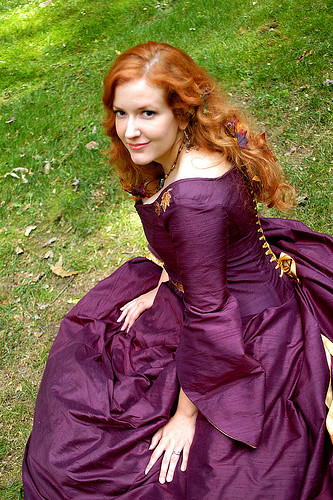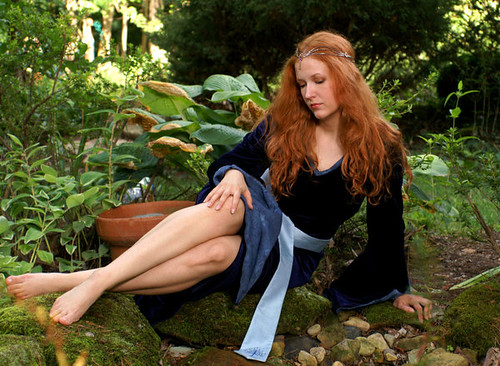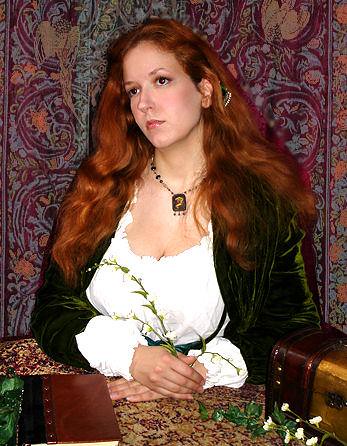An Interview with Grace Nuth by Rickey Pittman

Facebook and my love for Pre-Raphaelite art led me to discover Grace Nuth, a librarian (this blog knows how I adore librarians and my other librarian friends are on my list to interview as well), and she is a beautiful and multi-talented lady who graciously consented to an interview. Though we touch on many issues and topics in the interview, the focus is on the art, personalities, and influence of the Pre-Raphaelites. I intend to follow up this interview with a blog entry compiling various quotations related to this most compelling of artistic movements. Below is the interview, followed by photos of Grace. Anything in brackets is added by me.
1. How did your love for Pre-Raphaelite art begin?
It was a winding journey, but one with a definite destination! In 1993, I first heard the otherworldly voice of Loreena McKennitt, and was instantly captivated. Throughout the years, she has remained my favorite singer and a force in my life. One of her best-known songs, “The Lady of Shalott,” is based on the Tennyson poem of the same name. In 1995, while on vacation with my family, I came across a poster in an art gallery in a mall in the city we were visiting. I was instantly transfixed, and bought the poster without hesitation. It was of course J.W. Waterhouse’s famous painting of the Lady in the poem and song, and it was through Waterhouse that the path was opened to the original Pre-Raphaelite Brotherhood and all of their beautiful works. I was hooked.
2. Why do you think the Pre-Raphaelites have had such an attraction to you and to thousands of others?
Having a general interest and fascination with art, I’ve read plenty of books and reviews on the subject of art history and criticism. And frankly, many critics are snobs. They argue that Pre-Raphaelite art is too twee [Something that is sweet, almost to the point of being sickeningly so], too precious, too romanticized, too photographic, but most of all, too illustrative…and yet it endures. It endures more passionately and actively than many other art movements. And, to tie in with your next question, I believe a large part of that reason is because the art itself is so illustrative. And what’s so bad about that? What we love about Pre-Raphaelite art is what we love about a good book…we can get lost in the story, captivated by the moment we see, and all of the context that led up to that one frozen moment in time. Burne-Jones’ famous quote about his art applies here: “I mean by a picture, a beautiful romantic dream of something that never was, never will be – in a better light than any light that ever shone – in a land that no-one can define or remember, only desire – and the forms divinely beautiful” – Edward Coley Burne-Jones
3. What connection did literature have with the movement?
Oh my…it might be easier to ask what artworks by the Pre-Raphaelites weren’t inspired by literature! The original goals of the Pre-Raphaelites were to paint according to nature, express genuine ideas, reject the things in art tradition that don’t work, and create good art…none of which includes anything about painting from literature. However, the Pre-Raphaelites were also romantics, and they were so inspired by the Romantic poets (Keats, Tennyson, Shelley, etc) that they began to paint pieces based on their work, as well as the classics of Shakespeare. It was in large part because of the romanticism of Rossetti, and the Arthurian fascination of dear friends William Morris and Edward Burne-Jones that the ‘second generation’ of Pre-Raphaelites became so intrinsically known for painting pictures based on poems, legends, and various stories. But the Pre-Raphaelites were no “mere” illustrators either. Their fondness of romantic literature was perhaps only eclipsed by their love for symbolism, and it is the use of this symbolism in their art (as well as the knowledge of art’s scientific principals) that elevate their work beyond being considered simply illustrative.
4. You yourself have been described as a “Pre-Raphaelite model.” In your mind, what kind of woman does this phrase describe?
First, oh bless you…I have to give you an enormous virtual-hug for that comparison. To me, any physical compliment involving the Pre-Raphaelites is the absolute ultimate. And to be quite honest, I think any similarity can be attributed to the fact that from the age of 15-on, I viewed the Pre-Raphaelite woman as the absolute epitome of beauty to emulate.
The Brotherhood were genius artists who based their work around a lofty ideal. However, they were also young gentlemen with libidos, and they didn’t hesitate to behave mischievously on occasion. They called the female models they discovered, usually in the lower-classes, as “Stunners,” and congratulated each other when a new one was discovered. But these women, although often delicate in looks and health, held an inner strength of character. I think especially of the movement’s two most famous ladies, Lizzie Siddal and Jane Morris. Both women were beautiful, in very different ways, but they both harbored mystery behind their eyes and had many secret talents: Lizzie exhibited talent at painting, and Jane was accomplished with the needle, as well as being a driving force behind both William Morris’ and Rossetti’s lives and careers.
So, although I could go on and on about the physical appearance of the Pre-Raphaelite model (long red or dark hair, deep eyes, graceful hands, mysterious demeanor), the description “Pre-Raphaelite model” to me more represents a woman of strength of character and hidden depths. The women who were associated with the movement were absolutely remarkable ladies.
5. What books and films would you recommend to anyone wanting to study the Pre-Raphaelites?
Unfortunately, the best dramatization I’ve seen of the Pre-Raphaelites is a movie that’s pretty hard to come by…Dante’s Inferno Although it’s spotty in parts, some of the casting is absolutely spot-on, and gives one a feeling of being a part of the actual Pre-Raphaelite experience. There is also a brand new film adaptation of The Lady of Shalott inspired by Waterhouse’s artwork, hot off the presses and available on DVD here: and a dramatized miniseries coming out soon from the BBC on the Brotherhood, Desperate Romantics. It is far easier to learn about the Pre-Raphaelites through books, and so many of them are really quite good. Some of my favorites include
Pre-Raphaelite Art in the Victoria and Albert Museum
William Morris by Linda Parry
Edward Burne-Jones, Victorian Artist-Dreamer by Stephen Wildman et al.
Jane Morris: The Pre-Raphaelite Model of Beauty by Debra N. Mancoff
J.W. Waterhouse by Peter Trippi
6. Are there any trends or events associated with or promoting the work of the Pre-Raphaelites that my readers should know of?
Well, if you live anywhere in the vicinity of London or Quebec, hie thee to the Waterhouse exhibit! There’s an amazing exhibit of his work going on right now, entitled Waterhouse: The Modern Pre-Raphaelite, and from pictures at its first stop in the Netherlands, it’s remarkable. I also have to give a shout-out to the William Morris Society (which, sadly I have not the funds to join, but greatly admire) who regularly hold absolutely wonderful-sounding talks and events, especially around the New England area. A couple of years ago, a few kindred spirit friends and I jokingly discussed starting a “Pre-Raphaelite Convention,” which would be an absolute dream…a mixture of Medieval Festival, Victorian Fest, with food, scholarly discussions and panels, and booths where one could buy artisan items inspired by the Pre-Raphaelites. Ah, if only. Perhaps someday it will be real.
7. What is your favorite anecdote/story of a Pre-Raphaelite? (Mine is Rossetti digging up the grave to get the poetry back)
I’ve been pondering this question for a few days, ever since you asked it, and I have to give a somewhat cheating answer. I’d request permission to do a top-5 list rather than just one, since there are so many incredibly delightful stories about the P.R.B., it’s so hard to choose one in particular.
5. Rossetti’s elephant. Rossetti had a remarkable menagerie of animals he kept in his back yard, prompting many complaints from neighbors. But he always yearned for an elephant to complete his collection. He jokingly said that he would train the elephants to wash his windows, and when people walked by, they would say ‘there lives a remarkable man.’
4. Please Ring Bell. When the PRB was first founded, it was agreed (in jest) that the Brotherhood could put a sign outside its door with its initials, and anyone not in on the secret would think it stood for “Please Ring Bell”
3. The meeting of Fannie Cornforth. Depending on who tells the story, Fannie, one of Rossetti’s favorite models, either met the artist when she thew nut shells at him in the park, or when a group of the rowdy artists bumped into her on a crowded street, “accidentally” dislodging her hair until it tumbled around her shoulders. Both stories have their incredible charm, and either way, I love them!
2. Si Je Puis. This was William Morris’ personal motto, and means “If I can.” However, during the early days of Red House, (Morris’ beautiful home he had built for him and his new wife) one sneaky trickster among his friends modified a set of scrolls on the wall, inscribed with the motto, to instead read “As I can’t” in Latin.
1. …But I love you. Although I love all the humorous tales of the Pre-Raphaelites, my favorite story has to be William Morris’ declaration of love for Janey on the canvas for his painting. When he first met her, he asked to paint her portrait as Queen Iseult, and he quickly grew frustrated at his lack of ability to capture her on the canvas. As legend goes, he wrote “I cannot paint you, but I love you” on the canvas (I have read that it was on the painting itself, and also that it was on the reverse side), shyly declaring his feelings for her. It would be his only ever completed oil painting.
8. How would YOU define “Pre-Raphaelite”?
Pre-Raphaelite art is above all else symbolic and illustrative. It is often identified by an almost photographic realism (truth to nature), often uses the language of flowers in its symbolism, and has figures posed dramatically and sometimes somewhat artificially, but always in an aesthetically pleasant and enchanting way. Pre-Raphaelite art is art that draws you in, and feels like a frozen single perfect moment captured in time. It encourages the viewer to ask, “What happened before and after?”
This is of course not an exhaustive definition of Pre-Raphaelite, but it is certainly how I would define it!
9. Tell me about your own personal art and your thoughts on creativity.
Art has been an intrinsic part of my life since late elementary school. My parents encouraged my passion for it, and I had several art lessons throughout school. I came very close to making art my college major, but changed at the last minute when practicality screamed at me that an English degree would be far more helpful towards career acquisition than a Fine Art degree. However, I never stopped loving art. Most recently, inspired by the Pre-Raphaelite desire to create beauty all around them in their decor as well as their canvases, I’ve started painting unfinished wooden boxes with illustrative acrylic artworks. I also have painted murals on my walls and on the windows of the library where I work, and I’m currently working on a large mermaid painted with acrylics on a piece of wood that will be cut out and will act as a sign for the Sci-Fi/Fantasy section of the Teen department at the downtown library.
My Deviantart profile is here
Like many of the Pre-Raphaelites, I prefer to paint and draw figurative subject matter, and those from fairy tales, legends, myths, and stories. On a more theoretical level, I view the artistic pursuit of beauty to be my spiritual goal. I pursue this in all aspects of my life, and the new discovery of something beautiful is a source of elation and joy.
10. You and I have a mutual love for the art of John William Waterhouse. Tell me how Waterhouse fits into the Pre-Raphaelite discussion. What are your favorite works by Waterhouse?
Ahh, Waterhouse—the font of beauty. I truly feel that art simply gets no better than his work. J.W. Waterhouse both is and is not Pre-Raphaelite. By the strictest definition, he is not…he was not a member of the original Brotherhood, nor was he part of the second wave of artists (Morris, Burne-Jones, Rossetti, who was also an original member). His art could also be defined as Classicist because of his love for Greco-Roman imagery. But in many ways, his art is intrinsically Pre-Raphaelite, thus the catalyst for the name of the current exhibition of his works. I think I love Waterhouse not only for the intrinsic beauty of his images, but because his art style straddles the lines between the photographic realism of the first-generation Pre-Raphaelites, and the looser style of the Impressionists. If you look at Waterhouse’s art, much of the backgrounds and side details are rendered thickly and vaguely, but his central figures are always painted with absolutely flawless precision.
My absolute favorite painting by Waterhouse is his blue Ophelia (ahh…you thought I would say The Lady of Shalott, didn’t you?). It’s one of his more simple works, with just one central figure, and two vaguely rendered figures in the background, but the emotion in the piece is palpable, and of all artworks I’ve ever seen, I feel the most “kindred” to the central figure. She stares out at the viewer, eyes slightly unfocused, with loose flowers barely clutched in her upheld skirt. Her wild hair flows all around her, and she is caught in her own reality. From a nearby bridge, two passers-by stare at her in wonderment and no small amount of confusion. Who is this strange woman, and why does she act so peculiarly? Waterhouse’s blue Ophelia is the poster child for every lonely creative romantic girl out there, the child who wanders in the rain, reads books at recess, and creates her own world. [You can see that painting here]
I also love The Lady of Shalott too of course, and Circe Invidiosa and Hylas and the Nymphs are two other favorites. In context, another favorite is The Enchanted Garden , which was one of the last artworks painted by Waterhouse and was never fully completed. See my blog post on this piece here:
11. I believe you frequent Renaissance faires. Tell my readers something they likely don’t know about working for or with such events.
I’ve been to several Renaissance faires, and was a member of a reenactment group who were invited to participate in school days and a themed weekend at the Ohio Renaissance Faire. It’s always enjoyable to try to recreate the feel of the era as well as possible, bringing bread and cheese and meats with you to eat, sitting in the type of chair they may have used in those days. Costuming is another hobby of mine, and so Renaissance faires come naturally 🙂
12. Tell me a little about your blog and any website you promote or are associated with.
My blog, The Beautiful Necessity (thebeautifulnecessity.blogspot.com) was something I started in February of 2008. After meeting an amazing kindred spirit friend in early 2007, I realized from her avid enthusiasm for not only Pre-Raphaelite art, but the artists themselves, that there was more to the story than I was focusing on by just admiring the canvases. I became captivated by the lives of the artists themselves…they truly were absolutely amazing. The Beautiful Necessity was started as an extension of that passion. At the time, I wasn’t aware of any other blogs that were covering the Pre-Raphaelites exclusively. Granted, now I am aware of some, and I’d highly recommend you visit
http://www.theearthlyparadise.com/
http://preraphaelitepaintings.blogspot.com/
http://preraphaelitesisterhood.com/
Also, I have to acknowledge the website of the friend who encouraged my passion for the artists as well as the art:
http://www.midnight-muse.com/
and the website of another dear friend who makes the most beautiful jewelry known to man:
http://www.parrishrelics.com/

Grace Nuth

Grace Nuth

What a great post! So much interesting information, and great book suggestions (I also love her description of fans of the Blue Ophelia–so funny, and so true!). Grace’s blog is such a great resource, and I’m terribly flattered to be mentioned here!
I enjoy the art of the PRB as well, and enjoyed reading this post. Someone should have Grace sit for a painting.